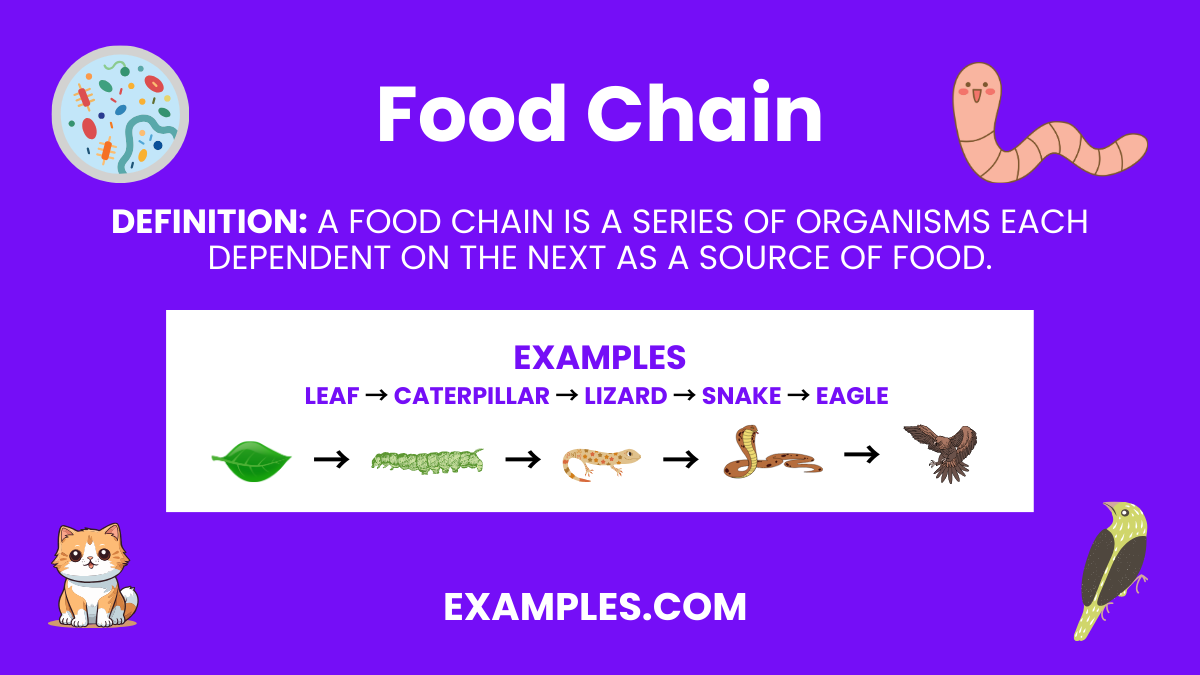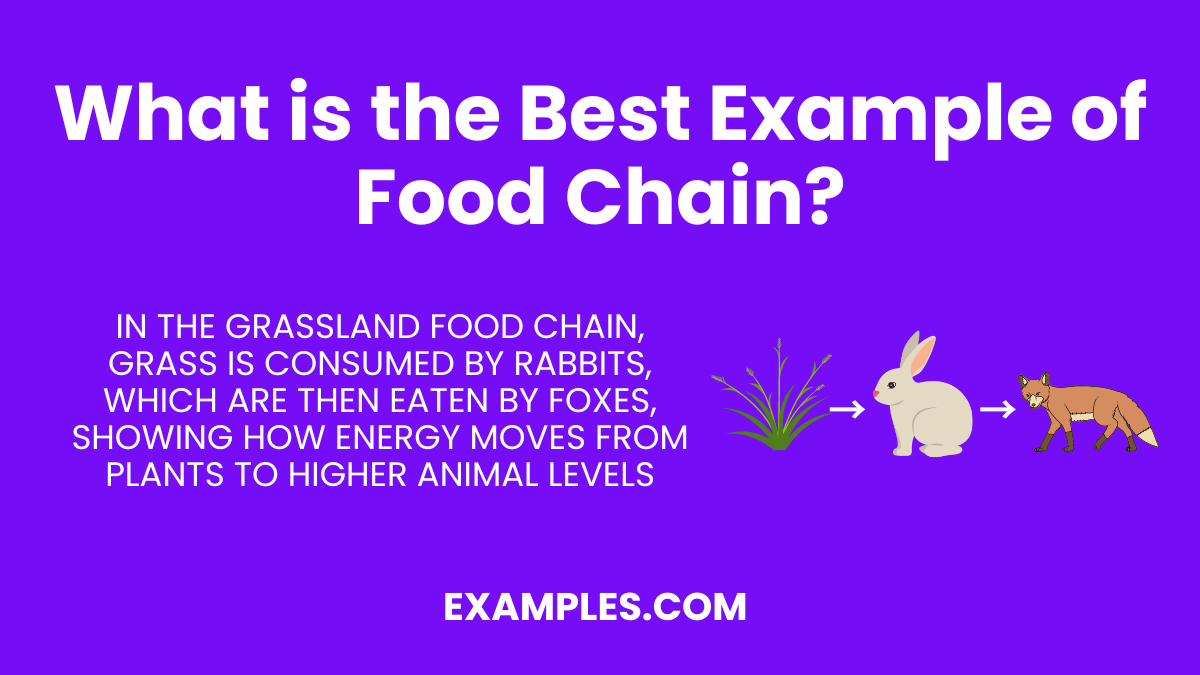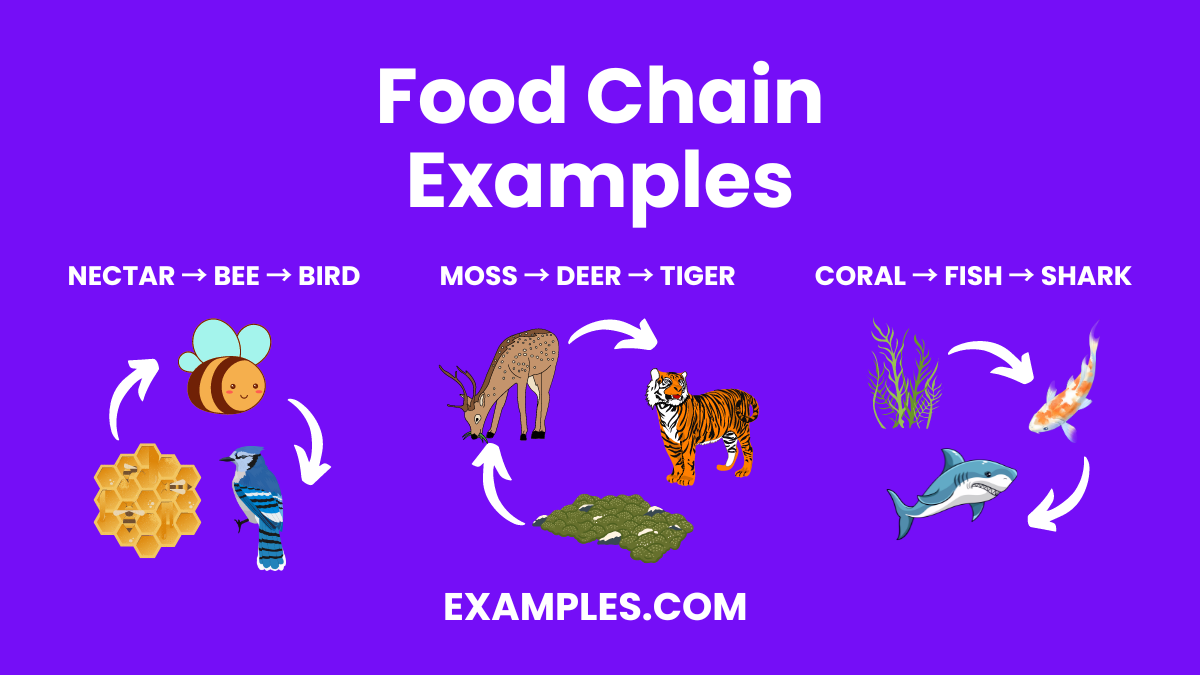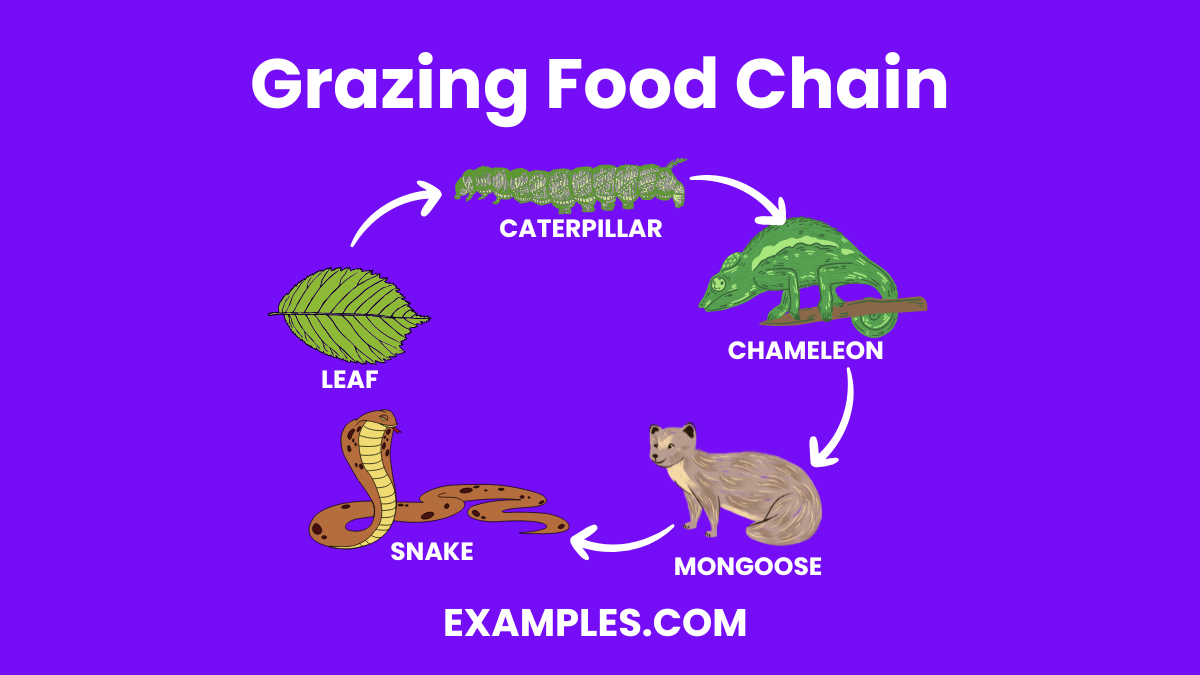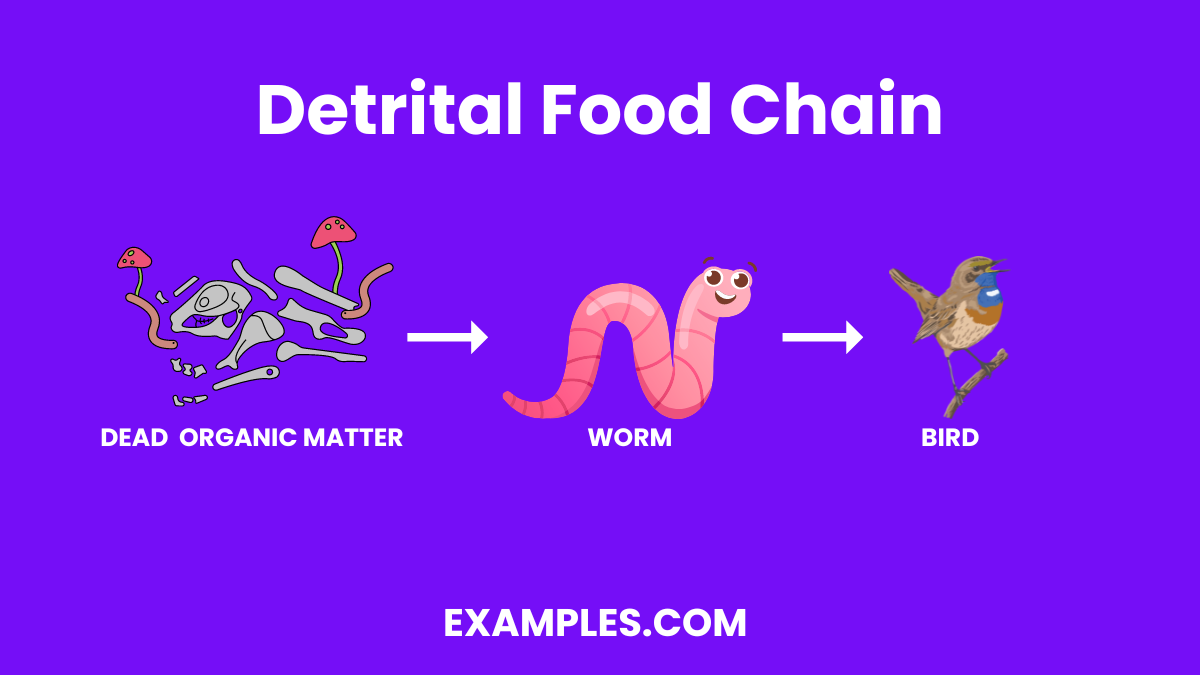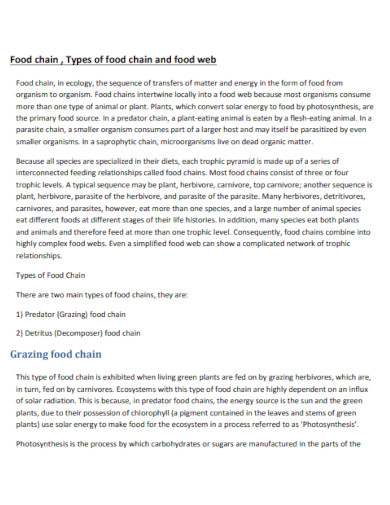Food Chain
A food chain is a fundamental concept in ecology, illustrating how energy and nutrients flow through an ecosystem. It represents the feeding relationships between organisms, from the simplest to the most complex. Our guide provides a clear understanding of food chains, enriched with real-world examples. It’s a valuable resource for teachers to explain the roles of producers, consumers, and decomposers. Simplified yet informative, this guide makes learning about food chains engaging and accessible for students, enhancing their ecological awareness.
What is Food Chain? – Definition
A food chain is a series of organisms each dependent on the next as a source of food. It starts with producers like plants, followed by consumers such as herbivores, and ends with top predators. This linear sequence demonstrates how energy and nutrients move through an ecosystem.
What is the Best Example of Food Chain?
A classic example of a food chain is the grassland ecosystem: grass (producer) is eaten by rabbits (primary consumers), which are then consumed by foxes (secondary consumers). This illustrates the direct energy flow from plants through various animal levels.
20 Food Chain Examples
Food chains illustrate the feeding relationships in ecosystems, showing how energy and nutrients flow from one organism to another. This list of 20 food chain examples, complete with meanings and usage, is an invaluable tool for teachers. Each example portrays a different ecological setting, demonstrating the variety in food chains from simple to complex environments. Understanding these examples helps students grasp key ecological concepts, such as energy transfer and the interdependence of living organisms.
- Grass ? Rabbit ? Fox: Shows energy transfer from plants to herbivores to carnivores.
- Algae ? Zooplankton ? Small Fish ? Large Fish: Aquatic chain, from microscopic producers to top predators.
- Tree Leaves ? Giraffe ? Lion: Represents savanna ecosystem.
- Phytoplankton ? Krill ? Whale: Antarctic marine food chain.
- Dead Organic Matter ? Fungi ? Mouse ? Snake: Decomposer-initiated chain.
- Coral ? Fish ? Shark: Coral reef ecosystem.
- Grass ? Insect ? Frog ? Snake ? Eagle: Wetland food chain.
- Plankton ? Herring ? Seal ? Polar Bear: Arctic food chain.
- Berries ? Bear ? Wolf: Forest ecosystem.
- Seaweed ? Crab ? Octopus: Coastal marine chain.
- Nectar ? Bee ? Bird: Pollinator-focused chain.
- Leaves ? Caterpillar ? Bird: Simple terrestrial chain.
- Grain ? Chicken ? Human: Agricultural food chain.
- Moss ? Deer ? Tiger: Forest chain in Asia.
- Cactus ? Lizard ? Hawk: Desert food chain.
- Algae ? Small Fish ? Flamingo: Shallow water food chain.
- Plants ? Antelope ? Hyena: African grassland chain.
- Bamboo ? Panda ? Leopard: Specific to Asian forests.
- Grass ? Cow ? Human: Farming-focused chain.
- Zooplankton ? Blue Whale: Marine chain with large mammal.
Types of Food Chain
Food chains are categorized into two main types: Grazing food chain and Detrital food chain.
Grazing Food Chain: Begins with primary producers like plants and moves up to herbivores and predators. An example is grass ? deer ? tiger, commonly seen in forest ecosystems.
Detrital Food Chain: Starts with dead organic matter consumed by decomposers like bacteria and fungi, followed by detritivores. An example is fallen leaves ? earthworms ? birds, seen in a forest floor ecosystem.
Aquatic Food Chain: Occurs in water bodies, starting with phytoplankton, followed by aquatic animals. For instance, phytoplankton ? small fish ? larger fish, typical in oceans or lakes.
Terrestrial Food Chain: Occurs on land, involving soil, plants, herbivores, and predators. A classic example is plant leaves ? caterpillars ? birds, found in garden ecosystems.
Each type of food chain plays a vital role in its respective ecosystem, showcasing different energy flow patterns and organism interactions.
Role of Food Chain
The role of a food chain is to illustrate the pathways through which energy and nutrients are transferred among different organisms within an ecosystem.
- Energy Flow: Demonstrates how energy moves from producers (like plants) to consumers (animals).
- Ecosystem Balance: Maintains ecological equilibrium by controlling population sizes.
- Nutrient Cycling: Helps in recycling nutrients back into the ecosystem through decomposition.
- Interdependence of Organisms: Highlights the reliance of species on one another for food.
- Biodiversity Indicator: Reflects the health and diversity of an ecosystem.
- Food Web Connection: Forms part of the larger food web, showcasing complex feeding relationships.
Example: A simple example is a grassland ecosystem where grass (producer) is eaten by rabbits (primary consumers), which are then consumed by foxes (secondary consumers). This chain showcases the flow of energy and the dynamic balance of nature.
Components of Food Chain
Food chains consist of several key components, each playing a vital role in the ecosystem:
Producers: These are organisms, typically plants, that produce their own food using sunlight (photosynthesis). They form the base of the food chain.
Example: In a forest ecosystem, trees and shrubs serve as primary producers.
Primary Consumers: These are herbivores that eat producers. They transfer energy from plants to the rest of the food chain.
Example: Caterpillars eating leaves in a garden ecosystem.
Secondary Consumers: These are carnivores or omnivores that eat primary consumers.
Example: Birds that feed on caterpillars.
Tertiary Consumers: Top predators that feed on secondary consumers, often without natural predators.
Example: Eagles that prey on smaller birds.
Decomposers: Organisms like bacteria and fungi that break down dead matter, returning nutrients to the soil.
Example: Fungi decomposing fallen leaves in a forest.
Food Chain in a Forest
A forest food chain vividly illustrates the complex interplay of various organisms:
Producers: Plants like trees, shrubs, and ferns, which use sunlight to produce food through photosynthesis.
Example: Oak trees providing acorns.
Primary Consumers: Herbivores that feed on these plants.
Example: Deer eating shrubbery and acorns.
Secondary Consumers: Smaller carnivores or omnivores eating herbivores.
Example: Foxes preying on small mammals like rabbits.
Tertiary Consumers: Top predators in the forest food chain.
Example: Hawks or wolves that might hunt smaller animals like foxes.
Decomposers: Organisms that break down dead matter, returning nutrients to the ecosystem.
Example: Mushrooms and bacteria decomposing fallen logs and leaves.
Steps of Food Chain
The food chain involves a series of steps, each representing a different level in the ecosystem’s energy flow:
Energy Production: Begins with producers, usually plants, that convert sunlight into energy through photosynthesis.
Example: Grass in a meadow producing its own food.
Primary Consumption: Herbivores, or primary consumers, eat the producers, transferring the energy to themselves.
Example: Rabbits feeding on the grass.
Secondary Consumption: Secondary consumers, typically carnivores or omnivores, consume the primary consumers.
Example: Foxes preying on rabbits.
Tertiary Consumption: Tertiary consumers, often apex predators, eat secondary consumers, occupying the top of the food chain.
Example: Eagles feeding on foxes.
Decomposition: Decomposers like bacteria and fungi break down dead organisms, recycling nutrients back into the ecosystem.
Example: Earthworms breaking down dead plant material.
Food Chain in PDF
How to Illustrate a Food Chain
A good food chain will empirically feature the organisms based on its trophic level, beginning the list at trophic level 1, which is dubbed the producers. Anything above trophic level 1 in the food chain is named consumers. If you are still unsure or confused about the concept of a food chain you may view any of the food chain examples, samples, and PDFs on the list above.
1.) Research About the Biome or Ecosystem
Begin by researching the specifics and details of the biome or ecosystem you are making a food chain on. The details should include the following the scavengers in the biome, the specific plants of the biome, the animals living in the biome, and the insects in the biome.
2.) List Down All the Organisms in the Biome or Ecosystem
After researching the different details of the biome, you will now need to list down and categorize the organisms in the biome. This will include plants, insects, and animals inside the biome or ecosystem.
3.) Separate the Organisms by Trophic Level
You will now use the listed down organisms and begin separating them by trophic level. Start by organizing all the producers like plants and worms on trophic level 1, and work your way up until you have completed the food chain.
4.) Draw Lines and Arrows Connecting the Organisms
When you have finished separating the organisms you must now draw lines and arrows representing the relationship these organisms have in relation to the food chain. The arrows can be used to indicate which organism consumes the other organism.


